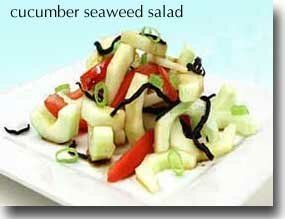healthy food tip and recipe
Today's Recipe
If you don't know what to serve for dinner tonight ...
If you are having difficulty adding seaweed (sea vegetables) into your Healthiest Way of Eating, try this easy-to-prepare salad and enjoy all of the extra minerals the sea vegetables have to offer.

Ingredients:
- 1 TBS dried arame or hijiki sea vegetables
- 3 cups cucumber, peeled, seeds scooped out, sliced
- 1 medium tomato, seeds and excess pulp removed, sliced
- 1 TBS minced scallions
- Dressing
- 3 TBS rice vinegar
- 2 TBS tamari (soy sauce)
- 1/2 TBS finely minced fresh ginger
- 1/2 TBS chopped fresh cilantro
- Extra virgin olive oil to taste
- Salt and white pepper to taste
- *For more on the safety of sea vegetables such as hijiki:
- The safety factors regarding sea vegetables, such as hijiki
- Rinse and soak arame or hijiki in warm water while preparing rest of ingredients.
- Peel cucumber and cut in half lengthwise. Scoop out seeds with a small spoon and slice thin.
- Cut tomato in half crosswise and squeeze out seeds. Quarter and cut out excess pulp. Cut into slices about 1/4-inch wide.
- Whisk rest of ingredients together. Squeeze out excess water from seaweed. Chop if necessary. You don't want seaweed pieces to be too large. Toss everything together and serve immediately.
In-Depth Nutritional Profile for Cucumber Seaweed Salad
Healthy Food Tip
Do pickles have about the same amount of nutrition as raw cucumbers?
There is some nutrient loss that occurs when a vegetable, like a cucumber, is pickled. The exact nutrients that are lost and the exact percentage depends on (1) the liquids you use to pickle and marinate and (2) the length of time you keep the vegetables in the solution before consuming them. A certain percentage of some water-soluble nutrients, like vitamin C, can naturally transfer to the pickling liquid over time.
Here are some specifics regarding cucumber pickles:
A raw unpeeled 8-inch cucumber weighs about 300 grams, provides about 45 calories of energy, and contains about 8.4 milligrams of vitamin C. Two 4-inch pickled cucumbers (sour, not sweet) weigh about 270 grams, provide about 30 calories of energy, and contain about 2.8 milligrams of vitamin C. So you can see that there is a moderate amount of vitamin C loss involved with the pickling process. I say "moderate" here because pickles do not contain a very large amount of vitamin C to begin with, and even though the loss is fairly high in terms of percentage, we are only talking about 5-6 milligrams here.
This same type of nutrient loss applies to a vitamin like folic acid. In the 8-inch raw cucumber referred to above, there are about 21 micrograms of folic acid. In the sour pickle example, there are only 2 micrograms. Once again, this nutrient loss is very substantial as a percentage, but since DRI (Dietary Reference Intake) recommendation for adults is 400 micrograms of folic acid each day, these 19 lost micrograms, while still important to notice, only constitute about 5% of the DRI requirement.
Many of the minerals in cucumber are contained in the skins, and keeping the skins on when pickling would be important if you wanted to maintain the mineral content. (Of course, I would highly recommend organic cucumbers, especially when leaving on the skins, since it's the skin that gets the most exposure to potentially toxic sprays.)
I don't object to the pickling of vegetables and think they definitely can have a healthy place in your Healthiest of Way of Eating. However, I do see them as significantly different (in terms of nutritional value) both from raw vegetables and from minimally cooked vegetables.


No comments:
Post a Comment